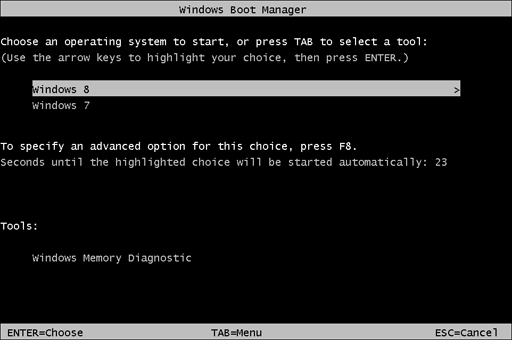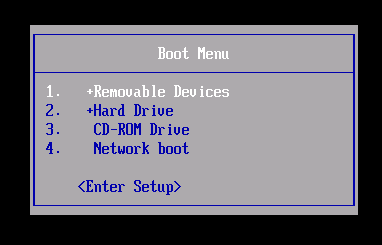

- #FORCE WINDOWS 10 BOOT MENU HOW TO#
- #FORCE WINDOWS 10 BOOT MENU DRIVERS#
- #FORCE WINDOWS 10 BOOT MENU SOFTWARE#
- #FORCE WINDOWS 10 BOOT MENU CODE#
The key to access HP Laptop Boot Menu on most of the model is the Esc key. ⦁ The general HP boot menu keys are Esc and F9. Note: Basic Input and Output System (BIOS) and Unified Extensible Firmware Interface (UEFI) are two conventional firmware types used to execute hardware configuration in the process of the computer booting. It helps the user choose which device to use for booting: CD, DVD, USB, flash drive, hard drive, or network. It is mandatory to access the HP boot menu when the user is installing a new operating system like Windows 10 or recovering data from a corrupted internal hard disk. If this error occurs, remove the disk and restart the computer. To boot to a USB Device, DVD, CD-ROM, there must be bootable files installed on the PC, or the system might be detoured and will load on what is already on the PC.Īn operating system not found error message may appear if a USB Flash Drive, floppy disk, or an optical disk is Plugged into a laptop or computer that does not carry an operating system. The default boot order determines what the system will be booting first. The default boot order settings for the computer are decided in the factory. UEFI, in short, is the successor of BIOS. The legacy boot is the process used to boot the laptop with BIOS firmware. The main difference between UEFI (or legacy boot) is that UEFI, the most recent method of booting a computer, is intended to replace BIOS. Another difference between UEFI & legacy boot is that UEFI is more secure and efficient than legacy boot. The legacy boot uses BIOS firmware to initiate the boot process. UEFI uses URFI firmware, which maintains a list of valid boot volumes called EFI Service Partitions. Legacy vs UEFI Boot Order – Which is Best for HP Laptops To find a EFI partition to start after the firmware checks the GPT. The UEFI firmware scans every bootable storage device connected to the system during Power-On Self-Test, verifying that all hardware functions correctly.

It keeps a list of boot volumes, called EFI service partitions. Some computers equipped with UEFI allow the user to activate legacy BIOS compatibility mode also.
#FORCE WINDOWS 10 BOOT MENU DRIVERS#
It prevents unsigned drivers from being loaded and protects against malicious software. UEFI allows you to control the interface with the mouse. Regular BIOS uses the keyboard to select options. UEFI is an excellent alternative and can recognize large storage drives. The standard BIOS cannot recognize large storage drives. Graphical User Interface (GUI) BIOS offers a blue screen with many options. It is user-friendly and has the most crucial benefit of all. UEFI Boot Order: Unified Extensible Firmware Interface (UEFI) is used in most new motherboards. If it doesn’t find one, the firmware proceeds to the next device. The firmware executes the bootloader to choose a partition to boot from if it finds a valid MBR. It then scans the file for a valid MBR (Master Boot Record). The firmware loads the first section of each storage target into memory after it has completed the POST procedure.

#FORCE WINDOWS 10 BOOT MENU CODE#
The code is used to identify the problem and provide further assistance. To indicate normal booting, the internal speaker emits a single beep. The BIOS performs Power On Self-Test when the computer is turned on. Legacy Boot Order: Legacy Boot is the BIOS firmware’s boot process, and it contains a list of bootable storage devices such as SSD, Hard Disk Drives, and Floppy Disk Drives. There are two types of boot order and they are as follows: The procedure in which the devices are checked is arranged by the Basic Input and Output System (BIOS). The computer can boot an operating system with the help of a floppy drive, hard drive, CD or DVD, USB storage, or a network. In the very beginning, when the computer is turned on, the Basic Input and Output System starts to scan a pre-determined list of drives and devices that may contain an operating system such as Windows. You can load up another operating system like Windows 10 physically by having access to the boot menu and making changes. Every single time you turn on your computer, you can choose to have an access boot menu or not. The boot menu is a menu in which you have an approach before entering the operating system. This is done by hardware in the CPU or by a separate processor in the system.
#FORCE WINDOWS 10 BOOT MENU SOFTWARE#
After a computer is turned on, the device’s Central Processing Unit has no software in its main memory, so some process must be installed so that it can be loaded. It can be started by hardware such as a button press or by software command.

#FORCE WINDOWS 10 BOOT MENU HOW TO#


 0 kommentar(er)
0 kommentar(er)
